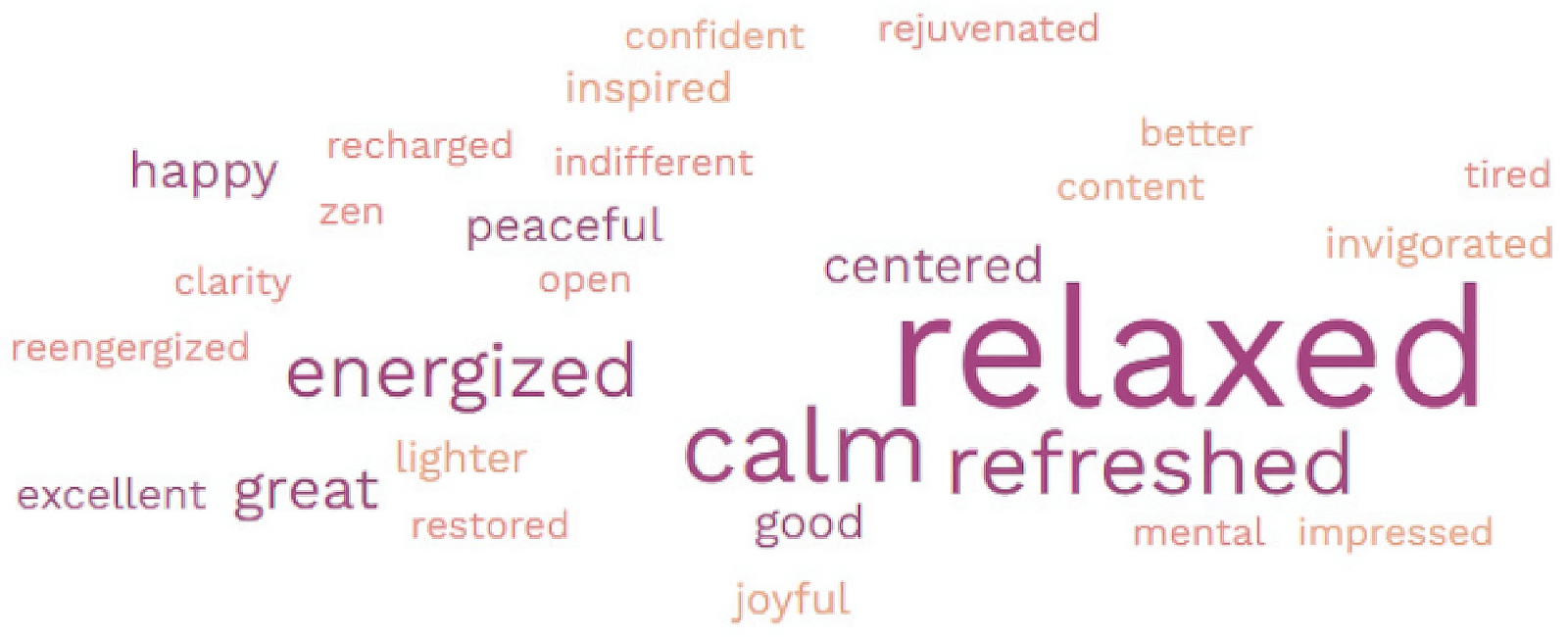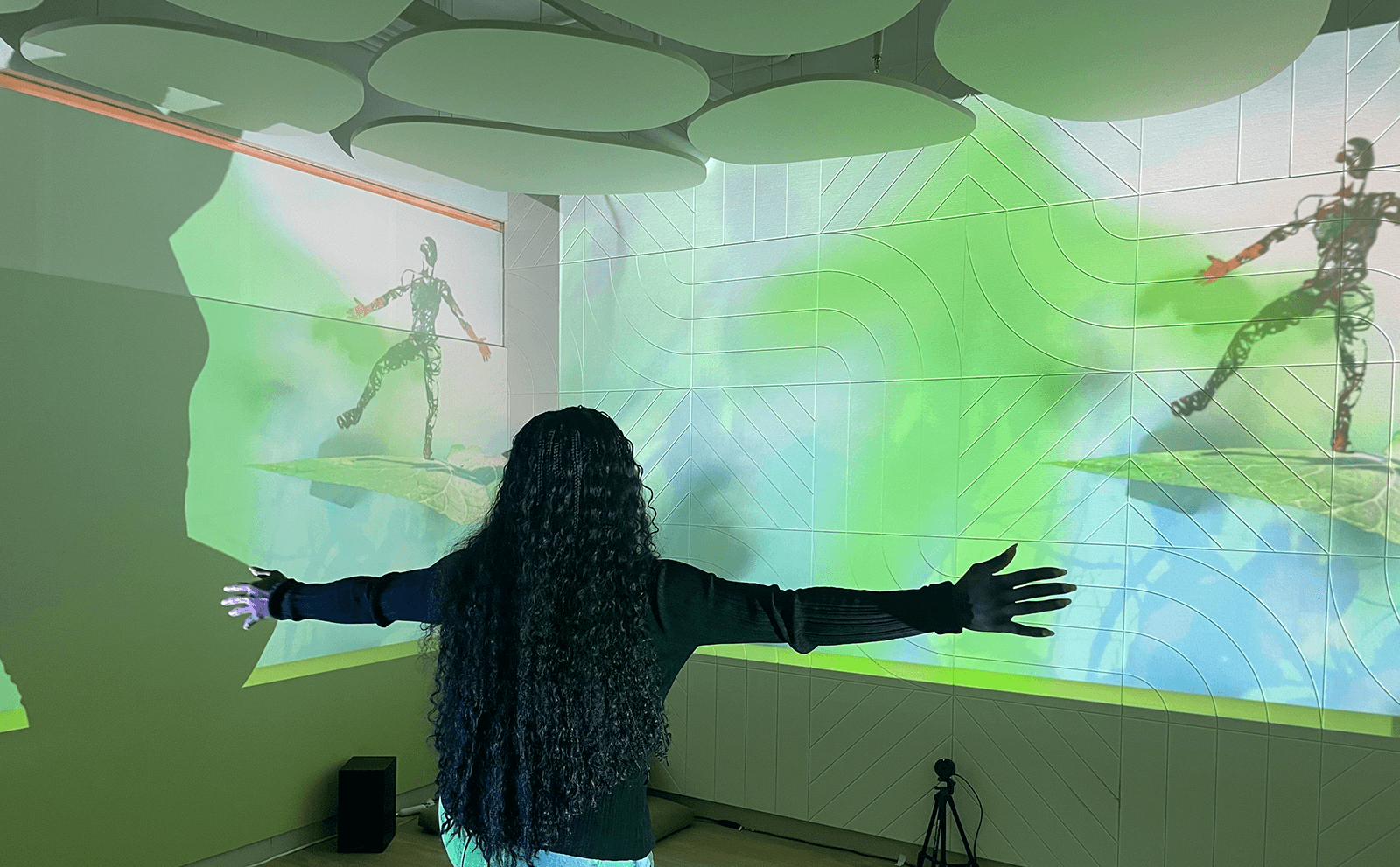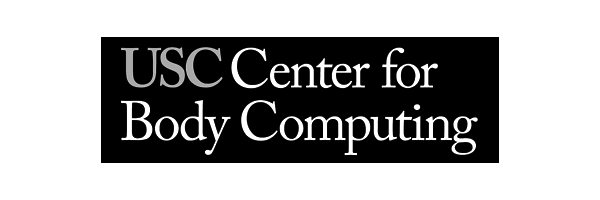
How to Improve Team Collaboration after Return to Office Mandates with Immersive Wellness Spaces
As organizations increasingly implement return-to-office mandates, we continuously hear from employees that they want an office based experience that does not feel virtual.
“Don’t ask me to drive the commute to sit next to people I don’t know on virtual calls with my team who I am not co-located with.” Returning to the office should bring something different to the workday that a home office cannot provide, a space with tools to be more productive, focused, and connected with colleagues on and off of their team.
What we hear them asking for is more place based experiences, and a deeper, more effective way to collaborate with colleagues. Employees are seeking a workplace that not only fosters personal connections but also boosts their energy, creativity, and inspires closer teamwork.
Returning to the office should offer more than the isolated and digital experience of working from home. It should provide a vibrant, engaging environment where employees feel empowered and excited to connect and collaborate.
How to improve employee engagement and team collaboration as employees return in-person.
Employees are looking for spaces that facilitate meaningful interactions and foster a sense of community. They want to move beyond the routine of virtual meetings and emails to a dynamic workplace where they can engage in face-to-face collaboration, share ideas spontaneously, and build stronger relationships with their colleagues. This environment should also support their well-being, offering opportunities for mental and physical recovery throughout the day. Connection through shared experiences is a valuable component of that.
To promote this future of work, Breakthru has created Wellbeing Rooms. Designed as a digital layer that can flow over the systems in the office already: the screens, the projectors, the conference rooms, create an immersive and interactive break room for employees to enjoy individually and share as a team. Breakthru Wellbeing Spaces are tunable to what individuals and teams need in the moment. There are options to move and breathe to build energy via guided mood based breaks or let the mind wander and be restored via soft fascination patterns and sounds from nature. Wellbeing rooms are a space for employees to get ready to collaborate in more meaningful and impactful ways and build a personal connection that working from home cannot provide.
Wellbeing Room participants have found that these rooms offer a consistent space for mental resets and purposeful rest. They leave feeling: relaxed, refreshed, energized, calm, and centered. Stress is dissipated. By integrating Wellbeing Rooms, you can create a workplace experience that supports both employee well-being and a team-oriented workplace culture.

Return to office mandates should not merely be about bringing employees back to their desks; it’s about creating an environment that offers more than what they can get from working at home. By providing spaces that enhance collaboration, creativity, and well-being, you can ensure that employees are not only returning to the office but are excited to do so.
How do you improve collaboration in the workplace?
Using onsite Wellbeing Spaces to build a team-oriented culture at work.
Breakthru’s Wellbeing Spaces offer employees the opportunity to engage in synchronized activities that not only enhance their energy and focus but also strengthen their trust, collaboration, and connection as colleagues. These Wellbeing Rooms provide a dedicated physical space where employees can come together, encouraging each other to prioritize their mind and body health while at work and participate in something personal together.
- Engaging in synchronous group activities can build even stronger social ties and create a greater sense of well-being. Moving in sync increases generosity, trust and tolerance toward others.7
- Moving together builds synergy and trust.8
- Taking short breaks allows those on your team to replay their memories of learning new skills, leading to strengthened memories and improved performance.9
- Performing physical exercise together with colleagues at the workplace induces psychosocial benefits compared with exercising at home.10
- Workers who performed physical exercise together with colleagues were less worn out and more energetic.10
- Performing exercises with colleagues during working hours may not only increase physical capacity, but also increase energy level and mood through “fun” non work-related active breaks.10
- Research shows that exercising in groups at work reduces physical exertion during work and need for recovery compared to exercising alone at home.10
- Researchers found that when separate groups who previously described one another negatively engaged in synchronous activity, they then expressed a greater sense of closeness and indicated more desire to see one another again.7

Teams often enter the Wellbeing Room together, seeking out ways and spaces to be social and connect on a deeper level. This shared experience fosters a sense of community and camaraderie, making it easier for team members to bond, support one another, and work together authentically. The Wellbeing Rooms also spark important conversations about the value of taking breaks and maintaining mental and physical health during the workday.
“After lunch I needed a break before going back to work. Normally I go for a walk, but this was a novel alternative. It's something people talk to each other about in the office together.” Participant survey response
Top 10 ways to use wellbeing rooms for team collaboration:
- To meet a new colleague
- To reestablish connections with colleagues that have been working remotely
- To meet colleagues who are not teammates
- To spend a few minutes with a friend
- To get inspired before a creative group brainstorming session
- To bring a team to calm during a training
- At events and trainings to break up learning sessions and connect with new colleagues
- A novelty to visit when teams are in office from offsite
- Host daily or weekly team movement or meditation sessions
- Create challenges that encourage the use of the room as a team

By offering a new and engaging space for employees to reconnect and collaborate, return-to-office mandates can be implemented more smoothly. These rooms are a stark contrast from the isolated experience of remote work, creating opportunities for teams to gain energy together and enjoy meaningful interactions. After several years of working remotely, Wellbeing Rooms can serve as a catalyst for new team bonding experiences, promoting a culture of wellness and collaboration.
Wellbeing Rooms are designed to be flexible and adaptable to the needs of different teams. Whether it’s a guided mood-based break to boost energy or a calming session with nature-inspired sounds to reduce stress, these spaces cater to the diverse needs of employees. This adaptability ensures that every team member can find value in the Wellbeing Rooms, making them a necessary part of the new workplace environment.
Incorporating Wellbeing Rooms into the office can significantly enhance the overall workplace experience. Employees who feel supported in their well-being are more likely to be engaged, productive, and motivated. By providing a space that prioritizes health and wellness as a team, organizations can create collaborative spaces and enhance the future of work, encouraging employees to return to the office or visit more frequently.
Breakthru’s Wellbeing Spaces are more than just a place to take a break; they are a powerful tool for fostering team cooperation and idea sharing and promoting a healthy, collaborative work environment. By integrating these spaces into the office, leadership can prove to employees that returning to the office will provide much more than virtual calls and email catch ups ever could. Thus, return-to-office mandates will be met with more enthusiasm and positivity, leading to a more connected and energized workforce.
How Wellbeing Rooms improve the health and wellness of employees in the workplace.
The importance of building onsite spaces that promote taking microbreaks throughout the workday.
It is important to provide employees returning to the office with experiences they couldn’t get at home. Providing a space where employees can go to refresh and reset their minds, allowing for more meaningful, focused, and productive work sessions can boost motivation for coming into the office.
Spaces like the Wellbeing Room that promote movement microbreaks can improve team’s mental health, well-being, productivity, performance, and energy levels.
- Those taking microbreaks experienced significantly lower job-related stress compared to their counterparts who maintained their regular sitting habits.1
- People were in a better mood on days when they took movement breaks, reporting more positive emotions, fewer negative feelings and more energy, and an average 25% reduction in fatigue.2
- Taking two microbreaks per hour have a positive impact on both mind and body that are comparable to prolonged breaks, and do not jeopardize workplace productivity.3
- Microbreaks improve performance for routine and complex cognitive tasks.4
- Moving for two minutes improves attention, concentration, learning and memory functions for up to two hours after the break.5
- 40 second microbreaks engaging with photos of nature leads to better post-break work performance.6
Whereas at home, workers may reach for another cup of coffee or a candy bar leading to a crash, at work they can immerse themselves in an experience that moves their body and mind and brings them more productive and less stressful workdays.

“Before, a microbreak was more about grabbing food or a drink, but now, the Breakthru room gave me a dedicated place to actually clear my mind.” Focus group Response

“What's interesting is it makes you feel different. I chose the joyful mode, and I feel that way, like elated.“ On-site observation
How to change work culture.
Using Wellness Rooms to create a positive culture at work where employees feel permissioned and encouraged to take microbreaks.
When organizations implement room-scale wellness initiatives like Breakthru’s Wellbeing Spaces, they can act as a physical reminder for employees to work together as a team and take breaks to improve their focus and energy.
Autonomy is a crucial aspect of effective health and well-being initiatives and the Wellbeing Room allows users to choose their own mood states or nature breaks and take them at times that work within their schedule. Autonomy, self‐selection, and the belief that the intervention will have benefits, are critical drivers of resource effectiveness.11, 12
“I enjoyed every aspect of the experience. Allows individuals to decompress at a time that works for them.” Participant survey response
The Wellbeing Rooms are also a physical embodiment of supervisor permission to connect with colleagues and add microbreaks to the workday, boosting the effectiveness of breaks.
Breakthru’s Wellbeing Rooms can provide what employees are missing working from home: better spaces to refocus, gain energy, and reset their minds and more meaningful and personal connections and collaboration with colleagues. When issuing return-to-office mandates, give your employees a space that is new, impactful, and makes them excited to come to work.
- Mainsbridge, C. P., Cooley, D., Dawkins, S., de Salas, K., Tong, J., Schmidt, M. W., & Pedersen, S. J. (2020). Taking a Stand for Office-Based Workers' Mental Health: The Return of the Microbreak. Frontiers in public health, 8, 215. https://doi.org/10.3389/fpubh.2020.00215
- Zomorodi, M., & Diaz, K. (2023, November 13). Sitting down all day is killing us: The cure is surprisingly simple—and difficult. Los Angeles Times. https://www.latimes.com/opinion/story/2023-11-07/sitting-sedentary-screen-device-work-health-diabetes-hypertension-exercise-fitness-npr
- Ahmed Radwan, Luke Barnes, Renee DeResh, Christian Englund & Sara Gribanoff | (2022) Effects of active microbreaks on the physical and mental wellbeing of office workers: A systematic review, Cogent Engineering, 9:1, 2026206. https://www.tandfonline.com/doi/full/10.1080/23311916.2022.2026206
- Albulescu, P., Macsinga, I., Rusu, A., Sulea, C., Bodnaru, A., & Tulbure, B. T. (2022). “Give me a break!” A systematic review and meta-analysis on the efficacy of micro-breaks for increasing well-being and performance. PLoS ONE, 17(8), 1–27. https://doi.org/10.1371/journal.pone.0272460
- Blomstrand, P., & Engvall, J. (2020). Effects of a single exercise workout on memory and learning functions in young adults—A systematic review. Translational Sports Medicine, 3(5), 437–446. https://doi.org/10.1002/tsm2.19
- Conlin, A., Hu, X., & Barber, L. K. (2021). Comparing Relaxation Versus Mastery Microbreak Activity: A Within-Task Recovery Perspective. Psychological Reports, 124(1), 248–265. https://doi.org/10.1177/0033294119900347
- Marta Zaraska, “Moving in Sync Creates Surprising Social Bonds among People,” Scientific American 323, 4, 64-69 (October 2020). https://www.scientificamerican.com/article/moving-in-sync-creates-surprising-social-bonds-among-people/
- Barbara Ehrenreich, “Dancing in the Streets,” Holt Paperbacks; 1st edition (December 26, 2007)
- National Institutes of Health. (2021, June 8). Study shows how taking short breaks may help our brains learn new skills. https://www.nih.gov/news-events/news-releases/study-shows-how-taking-short-breaks-may-help-our-brains-learn-new-skills
- Jakobsen, M.D., Sundstrup, E., Brandt, M. et al. Psychosocial benefits of workplace physical exercise: cluster randomized controlled trial. BMC Public Health 17, 798 (2017). https://doi.org/10.1186/s12889-017-4728-3
- Gilbert, E., Foulk, T., & Bono, J. (2018). Building personal resources through interventions: An integrative review. Journal of Organizational Behavior (John Wiley & Sons, Inc.), 39(2), 214–228. https://doi.org/10.1002/job.2198
- Sin, N. L., & Lyubomirsky, S. (2009). Enhancing well‐being and alleviating depressive symptoms with positive psychology interventions: A practice‐friendly meta‐analysis. Journal of Clinical Psychology, 65, 467–487. https://doi.org/10.1002/jclp.20593
- Nie, Q., Zhang, J., Peng, J., & Chen, X. (2023). Daily micro-break activities and workplace well-being: A recovery perspective. Current Psychology, 42(12), 9972–9985. https://doi.org/10.1007/s12144-021-02300-7
Breakthru in the World
Find out how Breakthru can work for your team
Fill in your details to request a meeting oremail us directly at info@breakthru.me for more information.
Breakthru has group functions (meeting and training integrations, setting Team and Company challenges, how managers use the gifting functions, etc), and launch support (comms materials, group onboarding workshops, etc) included in org wide deals.
Breakthru adds new breaks monthly to its large system of breaks, so the content is always growing throughout the year.
Movement based microbreaks protect against the negative health impact of sedentary behavior, prevent repetitive stress injury, and foster proprioception (body awareness).
For support with Breakthru, or questions,
please contact us at: info@breakthru.me
Join the
45,000+
corporations, educational
communities, and non-profits
worldwide using Breakthru.















